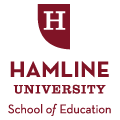Term
Fall 2021
Capstone
Capstone Project
Degree Name
MAT
Facilitator(s)
Betsy Parrish
Content Expert
Lisa Berken
Abstract
Research consistently finds that for minority students, it is important that they see themselves reflected in the classroom curriculum; educators must celebrate and incorporate the unique perspectives and backgrounds that minority students bring to class rather than focusing solely on any perceived deficits (Gay, 2018; Hammond, 2014; Ladson-Billings, 2001, 2014, 2018; Muhammad & Mosley, 2021). Additionally, those who come from “Asian” families tend to be lumped together whenever demographic information is collected or used to inform policy. As a result, there are a lot of curriculum guides for Asian students that do not focus on Hmong or even Karen students, who are newer immigrants to the United States. The unit designed for this project uses a culturally responsive teaching approach that seeks to teach to and through the multicultural differences among students at a large charter school in Minnesota, focusing on as many aspects of culture and identity as defined by Gay (2018) and Muhammad & Mosley (2021) as possible. The majority of students are Hmong or Karen, with a smaller number of black, white, hispanic, or multi-racial students. The unit was designed using the Understanding by Design Framework (Wiggins & McTighe, 2011) by using “backwards design” and can be implemented over the course of one quarter, or approximately two-three months, and consists of five major parts: An introduction to biography, autobiography, and memoir, a selection of chapters from Maxine Hong Kingston’s The Woman Warrior, literature circles on selected chapters from autobiographical graphic novels, autobiographical music, and a final personal narrative writing project. In the end, this project is intended to provide a diverse group of students from primarily Asian immigrant backgrounds an opportunity to explore how people navigate “truth” in autobiographical narratives. They will see how authors, musicians, and others use elements of fiction in order to get at emotional truths that might be harder to portray using only “factual” representations of a memory or event. Students will use the skills they learned through analyzing different forms of autobiography and memoir to create their own personal narrative projects exploring their own identities.
Project Type
Curriculum
Keywords
Curriculum, ESL/ ELLs, Multicultural Education, Culturally Responsive Teaching
Recommended Citation
Bolduan, Alexandra, "Developing Culturally Responsive Curriculum for High School Hmong and Karen ELA Students" (2021). School of Education and Leadership Student Capstone Projects. 728.
https://digitalcommons.hamline.edu/hse_cp/728
dc_type
text
dc_publisher
DigitalCommons@Hamline
dc_format
application/pdf
dc_source
School of Education Student Capstone Projects

